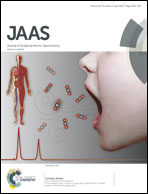Non-chromatographic speciation of inorganic arsenic by atomic fluorescence spectrometry with flow injection hydride generation with a tetrahydroborate-form anion-exchanger†
Abstract
A method has been developed for the determination of arsenite and arsenate in natural water samples based on the generation of arsine (AsH3) from the reaction between the arsenic species in the injected solution and tetrahydroborate immobilized on a strong anion-exchange resin (Amberlite IRA-400). Speciation was based on two different measurement conditions: (i) acidification to 0.7 M with HCl, and (ii) acidification to 0.1 M with HCl in the presence of 0.5% L-cysteine, which produced two calibration equations with different sensitivities for each species. The LOD for a 0.5 mL sample volume was 13 ng L−1 and 15 ng L−1 for arsenite and arsenate, respectively. The precision, expressed as % relative standard deviation of the measurement of 0.5 μg L−1 As was 4.3% and 4.1% for determination of arsenite and arsenate, respectively, in 0.7 M HCl; and 3.8% and 3.6%, for the determination in 0.1 M HCl and 0.5% L-cysteine. Interferences from transition metals and hydride-forming elements were eliminated by the addition of L-cysteine. The method was evaluated by the analysis of spiked natural waters. The recoveries for 0.5 and 1 μg L−1 arsenite were 92–108% and 88–112%, respectively; the recoveries for 0.5 and 1 μg L−1 arsenate were 94–111% and 95–112%, respectively. This method was also validated by the accurate analysis of a seawater certified reference material, NASS-6, which contains 1.43 ± 0.12 μg L−1 (total arsenic). The method was applied to the analysis of a number of real water samples, none of which contained arsenic below the method detection limit. The time required per measurement was less than 4 min and the procedure consumes about 100-times less hydrochloric acid that the conventional continuous-flow procedure.


 Please wait while we load your content...
Please wait while we load your content...